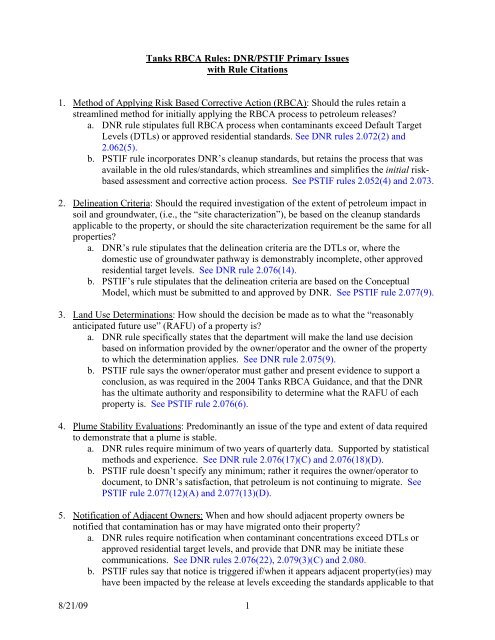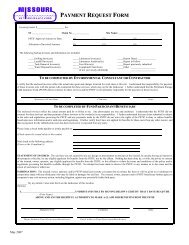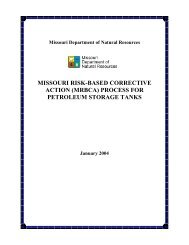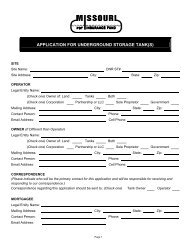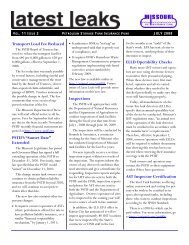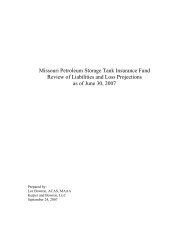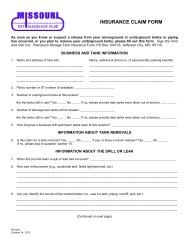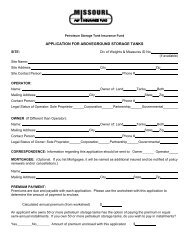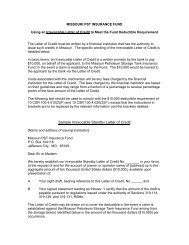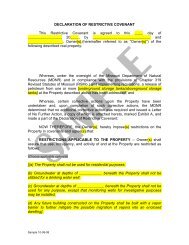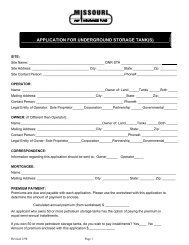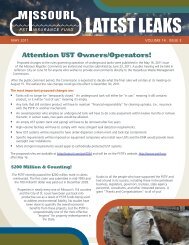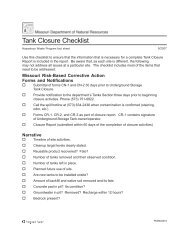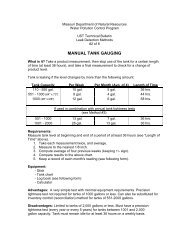8/21/09 1 Tanks RBCA Rules: DNR/PSTIF Primary Issues with Rule ...
8/21/09 1 Tanks RBCA Rules: DNR/PSTIF Primary Issues with Rule ...
8/21/09 1 Tanks RBCA Rules: DNR/PSTIF Primary Issues with Rule ...
You also want an ePaper? Increase the reach of your titles
YUMPU automatically turns print PDFs into web optimized ePapers that Google loves.
<strong>Tanks</strong> <strong>RBCA</strong> <strong><strong>Rule</strong>s</strong>: <strong>DNR</strong>/<strong>PSTIF</strong> <strong>Primary</strong> <strong>Issues</strong><strong>with</strong> <strong>Rule</strong> Citations1. Method of Applying Risk Based Corrective Action (<strong>RBCA</strong>): Should the rules retain astreamlined method for initially applying the <strong>RBCA</strong> process to petroleum releases?a. <strong>DNR</strong> rule stipulates full <strong>RBCA</strong> process when contaminants exceed Default TargetLevels (DTLs) or approved residential standards. See <strong>DNR</strong> rules 2.072(2) and2.062(5).b. <strong>PSTIF</strong> rule incorporates <strong>DNR</strong>’s cleanup standards, but retains the process that wasavailable in the old rules/standards, which streamlines and simplifies the initial riskbasedassessment and corrective action process. See <strong>PSTIF</strong> rules 2.052(4) and 2.073.2. Delineation Criteria: Should the required investigation of the extent of petroleum impact insoil and groundwater, (i.e., the “site characterization”), be based on the cleanup standardsapplicable to the property, or should the site characterization requirement be the same for allproperties?a. <strong>DNR</strong>’s rule stipulates that the delineation criteria are the DTLs or, where thedomestic use of groundwater pathway is demonstrably incomplete, other approvedresidential target levels. See <strong>DNR</strong> rule 2.076(14).b. <strong>PSTIF</strong>’s rule stipulates that the delineation criteria are based on the ConceptualModel, which must be submitted to and approved by <strong>DNR</strong>. See <strong>PSTIF</strong> rule 2.077(9).3. Land Use Determinations: How should the decision be made as to what the “reasonablyanticipated future use” (RAFU) of a property is?a. <strong>DNR</strong> rule specifically states that the department will make the land use decisionbased on information provided by the owner/operator and the owner of the propertyto which the determination applies. See <strong>DNR</strong> rule 2.075(9).b. <strong>PSTIF</strong> rule says the owner/operator must gather and present evidence to support aconclusion, as was required in the 2004 <strong>Tanks</strong> <strong>RBCA</strong> Guidance, and that the <strong>DNR</strong>has the ultimate authority and responsibility to determine what the RAFU of eachproperty is. See <strong>PSTIF</strong> rule 2.076(6).4. Plume Stability Evaluations: Predominantly an issue of the type and extent of data requiredto demonstrate that a plume is stable.a. <strong>DNR</strong> rules require minimum of two years of quarterly data. Supported by statisticalmethods and experience. See <strong>DNR</strong> rule 2.076(17)(C) and 2.076(18)(D).b. <strong>PSTIF</strong> rule doesn’t specify any minimum; rather it requires the owner/operator todocument, to <strong>DNR</strong>’s satisfaction, that petroleum is not continuing to migrate. See<strong>PSTIF</strong> rule 2.077(12)(A) and 2.077(13)(D).5. Notification of Adjacent Owners: When and how should adjacent property owners benotified that contamination has or may have migrated onto their property?a. <strong>DNR</strong> rules require notification when contaminant concentrations exceed DTLs orapproved residential target levels, and provide that <strong>DNR</strong> may be initiate thesecommunications. See <strong>DNR</strong> rules 2.076(22), 2.079(3)(C) and 2.080.b. <strong>PSTIF</strong> rules say that notice is triggered if/when it appears adjacent property(ies) mayhave been impacted by the release at levels exceeding the standards applicable to that8/<strong>21</strong>/<strong>09</strong> 1
property, (based on its current and future use), and rely primarily on procedurestraditionally used by owners and their consultants to gain legal access to thoseproperties. See <strong>PSTIF</strong> rules 2.073(1)(A), 2.076(1), 2.077(9).6. LTS: What is the purpose of “long term stewardship” and how can that purpose best beachieved?a. LTS required when contaminants will remain above residential targets. <strong>Rule</strong>differentiates between the need for enforceable and informational LTS. Enforceablerequired when actions could cause a pathway to become complete, when anengineered control is used, and where otherwise determined to be necessary.Otherwise, informational device sufficient – in particular when land use is onlyreason for LTS. See <strong>DNR</strong> rules 2.079(2), 2.079(5)(C), and 2.081.b. <strong>PSTIF</strong> rules do not contain any requirements for owners/operators to “do LTS” anddo not require the use of Activity & Use Limitations (AULs) under anycircumstances. Rather, AULs are allowed as one of various corrective action optionsto address risks. See <strong>PSTIF</strong> rules 2.079(3) and 2.079(11).7. Elimination of Soil-Type-Specific RBTLs: Eliminate the three sets of Tier 1 Risk BasedTarget Levels (RBTLs) developed in 2005.a. <strong>DNR</strong> rules keep the soil type dependent RBTLs in Tier 1. See <strong>DNR</strong> rule 2.075(7)(G),2.076(11), and 2.078(2)(B).b. <strong>PSTIF</strong> rules re-establish Tier 1 RBTLs as “look-up” standards and incorporate sitespecificassessment and standards into Tier 2. See <strong>PSTIF</strong> rules 2.075 and 2.077.8. <strong>Rule</strong> Language References to the Department: How should the rules describe/incorporate<strong>DNR</strong>’s role and responsibilities?a. The department’s rules include more references to the department’s role as theauthority for the <strong>RBCA</strong> process and specific minimum criteria, most related to sitecharacterization. Regarding examples of specific minimum criteria, see <strong>DNR</strong> rule2.076; references to department’s role throughout.b. The <strong>PSTIF</strong> rules require the o/o to meet <strong>DNR</strong>’s requirements and submit one or morereports to <strong>DNR</strong>, and require the Department to review and approve/ disapprove theo/o’s reports/conclusions. However, the owner/operator and his/her consultant areresponsible for deciding how to meet <strong>DNR</strong>’s requirements. See <strong>PSTIF</strong> rules2.052(4); 2.061; 2.071(2); 2.072(3); 2.074(1)(E); 2.075(2)(H), (4), (6)(A), (7)(A), (8)and (9)(F); 2.076(6)(B); 2.077(15), (16) and (17)(A); 2.078(6); 2.079(2), (5), (7)(A),(7)(B), (9)(D), and (12.)9. <strong>Rule</strong> Structure: The structure of the <strong>DNR</strong> and <strong>PSTIF</strong> rules differ. <strong>PSTIF</strong> rule structure iscleaner, but that is in part due to the elimination of certain rules and rule provisionsthroughout. In particular, <strong>DNR</strong> rules 2.081 on “Long-Term Stewardship” and 2.082 on “NoFurther Remedial Action Determinations” do not appear in <strong>PSTIF</strong> rule package)10. Inclusion of RBTLs in the <strong><strong>Rule</strong>s</strong>a. <strong>DNR</strong> rules incorporate specific RBTLs by reference, but <strong>with</strong> qualifying language toallow the department to apply a different RBTL <strong>with</strong>out an immediate rule change ifthe scientific data used to develop the original RBTL changes. See <strong>DNR</strong> rule2.012(D)2 and 2.012(R)6.8/<strong>21</strong>/<strong>09</strong> 2
. <strong>PSTIF</strong> includes <strong>DNR</strong>’s RBTLs in their rule 2.078. This method of incorporationmeans that the department could not change a RBTL <strong>with</strong>out changing a rule. See<strong>PSTIF</strong> rule 2.078(3) and Tables 1 through 6.11. <strong>PSTIF</strong> Appeal <strong>Rule</strong>a. <strong>DNR</strong> did not include an appeals rule in its rule packageb. <strong>PSTIF</strong> has proposed an appeals rule. See <strong>PSTIF</strong> rule 2.<strong>09</strong>0.12. (Deleted.)13. Shall the definition of “site” be changed?a. <strong>DNR</strong> rules define “site” as “current and future areal extent of contamination…” See<strong>DNR</strong> rule 2.012(1)(S), p.847.b. <strong>PSTIF</strong>’s proposed rules define site as <strong>DNR</strong> traditionally defined it and in thesame way as it is defined in the <strong>PSTIF</strong> Board’s rules. See <strong>PSTIF</strong> rule 2.012(1)(S), p.8 of 9.14. Shall the term “free product” in the old rules be changed to “light non-aqueous phase liquid”(LNAPL) in the new rules?a. <strong>DNR</strong> rules change all or nearly all references in the old rules. Multiple places.b. <strong>PSTIF</strong> rules retain the old “free product” rule and add requirements to it; inaddition, separate and distinct requirements for “LNAPL” are included in the SiteCharacterization rule. For examples of where the <strong>PSTIF</strong> rules retain <strong>DNR</strong>’s currentrule language, see 2.060(1)(A); 2.061; 2.071(1)(C) and (F); 2.072(1)(D); and parts of2.074. For examples where <strong>PSTIF</strong>’s rules propose new language related to “freeproduct,” see 2.072(2)(B); parts of 2.074; 2.075(7); 2.076(4)(C) and (4)(D), (9),(10)(D)2.D and E; 2.077(2)(N); 2.077(13); 2.079(2)3; and 2.079(7).15. Shall the old public participation rule be retained or replaced?a. <strong>DNR</strong> rules replace the old rule <strong>with</strong> a new rule. See <strong>DNR</strong> rule 2.080.b. <strong>PSTIF</strong> rules retain the old rule <strong>with</strong> a change to one section. See <strong>PSTIF</strong> rule2.080.16. When USTs are removed and soil samples are collected from under the tanks and piping,what standards should the soil data be compared to?a. <strong>DNR</strong> rules require comparison <strong>with</strong> either the standards protective of thedrinking water ingestion pathway or, if that pathway is incomplete, the residentialindoor inhalation pathway. See <strong>DNR</strong> rule 2.062(5) and (7).b. <strong>PSTIF</strong> rules are similar, except the rule specifies that the current and futureland use be determined, then either the residential indoor inhalation standards or thenon-residential indoor inhalation standards are used, as appropriate, (and subject to<strong>DNR</strong> approval.) See <strong>PSTIF</strong> rule 2.052(4).8/<strong>21</strong>/<strong>09</strong> 3


